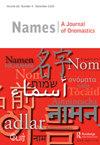Argument-Structure Constructions with Organization Names in the English Eurolect
IF 0.6
3区 文学
0 LANGUAGE & LINGUISTICS
引用次数: 0
Abstract
Construction Grammar (Hoffmann & Trousdale 2013) has received very little attention in onomastics, let alone corpus-based approaches, as corpora are just starting to be applied to the empirical study of names (Motschenbacher 2020). This study employs Named Entity Recognition plus verbal pattern extraction in an intermodal corpus (Bernardini 2016) of EU discourse, or Eurolect (Sandrelli 2018). The methodological aim is to mine English argument-structure constructions (Goldberg 1995) with subordinate clauses introduced by that and organization names in the subject slot ([ORG + V + that + SC]). First, the personification recognition method of Dorst, Mulder, and Steen (2011) is applied to quantitatively prove the strong relationship between the extracted argument-structure constructions and personification metaphors in EU discourse. Second, the constructions and their form-meaning pairings are described, both per subcorpus and globally. Results show that, at a macro- and meso-level of schematicity, the [ORG + V + that + SC] construction transversally symbolizes personification as an understanding scheme for institutional relations, constructing organization names with semantically human verbs of belief, speech, and thought. At a microscopic level, however, some constructions occur exclusively in one of the four subcorpora (non-translated, translated, non-interpreted, and interpreted English), meaning that they could be covering specific mediating functions through their name-verb slot choices.英语欧陆选集中带组织名称的论元结构结构
构式语法(Hoffmann & Trousdale 2013)在名词学中很少受到关注,更不用说基于语料库的方法了,因为语料库刚刚开始应用于名称的实证研究(Motschenbacher 2020)。本研究在欧盟话语的多式语料库(Bernardini 2016)或euroselect (Sandrelli 2018)中使用了命名实体识别和语言模式提取。方法上的目标是挖掘英语的论点结构结构(Goldberg 1995),由that引入的从句和在主题槽([ORG + V + that + SC])中的组织名称。首先,运用Dorst, Mulder, and Steen(2011)的人格化识别方法,定量证明了欧盟语篇中提取的论点结构结构与人格化隐喻之间的密切关系。其次,描述了每个子语料库和全局的结构及其形式-意义配对。结果表明,在图式的宏观和中观层面上,[ORG + V + that + SC]结构横向象征了拟人化作为机构关系的理解图式,用信仰、言语和思想等语义上的人类动词构建了组织名称。然而,在微观层面上,有些结构只出现在四个子语料库(非翻译、翻译、非解释和解释英语)中的一个语料库中,这意味着它们可能通过其名称-动词槽选择涵盖特定的中介功能。
本文章由计算机程序翻译,如有差异,请以英文原文为准。
求助全文
约1分钟内获得全文
求助全文
来源期刊

Names-A Journal of Onomastics
Multiple-
CiteScore
1.30
自引率
50.00%
发文量
23
期刊介绍:
Names, the journal of the American Name Society, is one of the world"s leading journals in the study of onomastics. Since the first issue in 1952, this quarterly journal has published hundreds of articles, reviews, and notes, seeking to find out what really is in a name, and to investigate cultural insights, settlement history, and linguistic characteristics revealed in names. Individuals subscribing to Names automatically become members of the American Name Society and receive the journal as part of their membership.
 求助内容:
求助内容: 应助结果提醒方式:
应助结果提醒方式:


